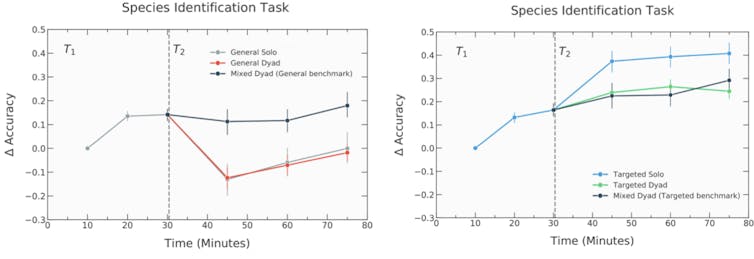[ad_1]
All through the twenty first century, teamwork has come to outline the fashionable work atmosphere. Pushed by advances in communication know-how, working collaboratively is, as administration consultants will inform you, the way you harness the “collective intelligence”.
Collective intelligence is commonly seen as better than the sum of its components: superior to the cumulative particular person intelligence of the group’s members. Capitalising on it is alleged to enhance activity accuracy (discovering higher and extra right solutions), and improve activity effectivity (discovering good solutions sooner). This in flip results in faster and better high quality completion. In different phrases, once we work collectively, our efficiency improves. This has been one of many main components shaping our fashionable societies.
On the similar time, although, each analysis and in style idiom underline the bounds inherent to the idea. If “two heads are higher than one” suggests the advantages of collaboration, “too many cooks spoil the broth” suggests the alternative.
I led a latest examine whether or not coaching and group composition would possibly have an effect on how environment friendly persons are when working collectively. We discovered that the advantages of collective intelligence could be outweighed by the price of having to coordinate between group members.

Fizkes/Shutterstock
The dynamics of teamwork
We designed an experimental examine utilizing an present on-line citizen science challenge, Wildcam Gorongosa. Individuals analyse webcam photographs taken in Gorongosa Nationwide Park, Mozambique, to seek out and determine animal species and behavior.
We invited 195 members of the general public to our lab in Oxford to take part. The experiment comprised two phases: coaching, then testing, which they did first on their very own after which in groups of two. They’d 5 subtasks to finish: detecting the presence of animals; counting what number of there have been; figuring out what they had been doing (standing, resting, shifting, consuming or interacting); specifying whether or not any younger had been current; and figuring out the animals from 52 attainable species (the choice of “nothing right here” was included, however not “I don’t know”).
We break up the members into two teams. One obtained focused coaching with photos just like the take a look at set. The opposite obtained basic coaching with a various vary of photos.
We discovered the kind of coaching did certainly have an effect on their efficiency. For these with basic coaching – the “generalists” – effectivity initially improved, however then declined, as soon as they had been examined on the particular set of take a look at photos. In contrast, these with focused coaching – the “consultants” – persistently maintained or improved their efficiency.
How efficiency modified through the coaching and testing phases:

Taha Yasseri, CC BY-NC-ND
To research the impression group dynamics would have, we then fashioned three forms of group: these featured both two consultants, two generalists, or a blended pair.
Surprisingly, we discovered that neither two generalists nor a blended group carried out higher than a single generalist working alone. Even two consultants working collectively didn’t do higher than a single skilled.
How the teams’ composition affected their effectivity:

Taha Yasseri, CC BY-NC-ND
We additionally discovered that whereas having an skilled in a gaggle improved accuracy for the extra advanced duties, it didn’t enhance the group’s effectivity. In different phrases, the group obtained extra right solutions however took significantly longer to take action. And for easy duties, there was no enchancment in accuracy from having an skilled. Finally, the time that group members misplaced in coordinating with one another outweighed the good thing about including an skilled to the group.
What can we are saying about the way forward for work?
Analysis has lengthy proven that underperformance in a gaggle is commonly because of what social psychologists time period “course of losses”. The collective intelligence of a group can, for instance, be adversely affected by social biases and what cognitive scientists name “herding” results, as a result of these can result in collective choices being disproportionately influenced by just a few members of the group who’re much less competent but extra assured.
Additional, psychologists talk about “social loafing” to explain an individual performing poorly as a result of they’re a part of a gaggle – they’ve the impression that others will do the job with out them needing to contribute. When a lot of group members comply with this technique, it can lead to the mixed efforts of the group being even decrease than the sum of particular person efforts.
Analysis additionally exhibits the significance of social studying within the context of efficient collaborative working, which our examine highlights. The experimental technique we carried out concerned particular person coaching classes adopted instantly by testing the teamwork – this precluded alternatives for folks to be taught by observing their coworkers’ efficiency, and subsequently one of many benefits of being a part of the group through the studying course of was eradicated.
The context by which teamwork and collaboration happen issues, as do the instruments accessible for coordination between group members. As internet-based communication applied sciences are used not just for large-scale voluntary collaborative endeavours, corresponding to citizen science initiatives, but additionally for distant working, you will need to recognise the potential results of various coaching approaches and group dynamics.
When group members don’t have the possibility to watch different employees and reap some great benefits of social studying, and when communication is much less environment friendly than face-to-face interactions, the prices and advantages within the teamwork equation can shift. Our analysis exhibits that that is much more pronounced while you’re coping with easier duties that don’t require in depth inventive problem-solving. Opting to work individually may certainly be a extra viable method.
The dynamics of teamwork – whether or not within the office or within the context of collective motion – are advanced. Whereas collaboration provides advantages in particular contexts, it’s important to think about the trade-offs between time, accuracy and effectivity. Coordination comes at a price.
[ad_2]

